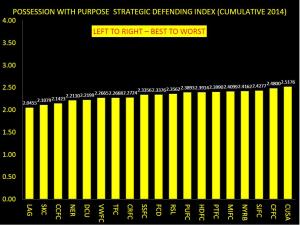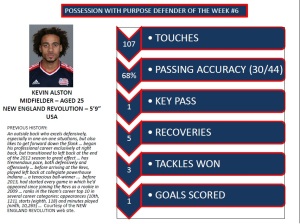Week 8: My PWP Pick List
/Two weeks in and my PWP-Pick-List is doing pretty well: If you tracked my picks from last week I nailed the wins by Seattle, Real Salt Lake, Sporting, FC Dallas, and the two draws - Vancouver v LA Galaxy and Chicago v New England. That's 5 for 9 in my first week (Week 6) and 6 for 10 in my second week (Week 7).
With that said, and if you've read my latest article on Expected Wins, (XpW) you'll know that I will no longer be picking draws as an outcome - granted they will happen, but since no team really goes into a game expected a draw then my picks won't either.
For now XpW won't be part of my PWP-Pick-List. Each team has only played 5-7 games so far, and that's not enough individual sample points to support a reasonable correlation (R2) that has relevance. Figure by Week 17 I'll start to include the R2 for each team (home and away games) and then by Week 24 I will start to separate out the R2 for Home games versus Away games.
For now my source in this effort is strictly my subjective view on the objective data that I collect as part of my Possession with Purpose analysis.
To begin, your Week 8 picks:
New York Red Bulls hosting Houston Dynamo: This is a hard call; Houston has David Horst back but Sarkodie is missing due to that red card last weekend. It seems to me that when all four of the back-four are in and playing this team is really tough to beat. That being said the Red Bulls got two goals against an improving Union side last week and they don't have a short week to prepare like Houston. Bottom line here is I see New York winning this game.
Seattle at home to Colorado: Dempsey didn't score against Chivas but he didn't need to - instead he began to show his value in creating space and assisting others in scoring goals. That additional value adds tremendous strength to the Sounders attack. On the other hand, Colorado is no slouch when it comes to winning away games so this will be a huge test to the Seattle back-four. Can they contain Brown? I think so and Seattle wins... though I wouldn't be surprised to see this game end 2-1 or 3-2 given the weaker center with the Seattle back-four.
Philadelphia travels to Montreal: In short - I simply don't see Montreal winning, or even getting a draw at home against a Union side that probably could have done better this past weekend. The Impact have one of the poorest performing teams on both sides of the ball, and Klopas (imo) simply runs an archaic (direct attacking) system that no longer belongs in the MLS - more mounting losses for Monreal, and by the summer transfer window I could see Klopas being given the heave-ho. Union win...
DC United entertain FC Dallas: A resurgent DC United with a quality striking partnership of Johnson and Espindola is working well as Kitchen runs the single pivot. A great matchup where DC United is likely to have more of the possession. That said Diaz and the creative midfield for Dallas can win this one and keep their strong start alive. If I would bet on a draw it would be this one but I think the edge goes to Dallas. IF DC United win this one then the Eastern Conference really needs to be considered about the positive confidence they'll gain with three points. If there was a game to be played on National TV this next weekend this would be a good one.
Columbus at home to New York: A short rest for the Red Bulls against a well rested Crew that are probably disappointed they didn't take three points from DC United. I think defense wins this game and in my view the defense for Columbus is better than what New York offers. Crew win...
Sporting KC travel to New England: The team formerly known as the wizards offered some offensive magic against a fast fading Montreal this past week and the Revolution will need to be in fine fiddle to control the volume of successful crosses I'd expect to see this game. Can the New England defense hold and will the ability of the KC back-four be enough to contain a Revolution side who have struggled at times to score this season. All told I'm not quite sure - I'd like to offer this as a draw as well but I think the improving attack, to go along with the best defense in MLS, gives Sporting the edge. I won't always pick Sporting to win every game this year, and against some Western Conference teams I won't, but for now SKC wins.
Real Salt Lake at home to Vancouver: Real continue to show quality versus quantity and they also continue to move up the ladder in my Composite PWP. Vancouver had two very tough games against LA back to back and the wicked attack (with a healthy Plata) won't get any easier in Rio Tinto. Real Salt Lake wins...
San Jose versus Chivas: The Earthquakes have yet to win a game this year and no better opportunity to do that than this week. Their continued use of crossing as a prime source for creating goal scoring opportunities should get them that three points provided Torres can be controlled in attack. He's shown an ability to score as well so this one probably doesn't see either team getting a clean sheet but I do think the Earthquakes take three.
Portland travels to Houston: Are the cards right for the Timbers to get their first three points? We saw Nanchoff come on as a late sub and Valeri, along with Kalif and others, seemed to struggle with their passing accuracy. Having vision and accuracy in tight spaces is what separated the Timbers last year from the Timbers this year. That and a healthy, well communicating back-four led by Ricketts. That being said Houston are coming into this game on short rest and Kinnear will want his players to stamp their irritating level of physical play early on. This is likely to be a VERY physical game for both teams but the edge for the Timbers needs to be real sharp as they are simply fed up with not winning. I think the Timbers find the back of the net and win. If it's Urruti great; but in this game, Valeri needs to score.
All for now and not an easy thing for me to ignore picking draws - but I remain steadfastly stubborn and stubbornly steadfast that teams don't enter games with an intent to get one point - so in my picks I won't either.
Best, Chris

















